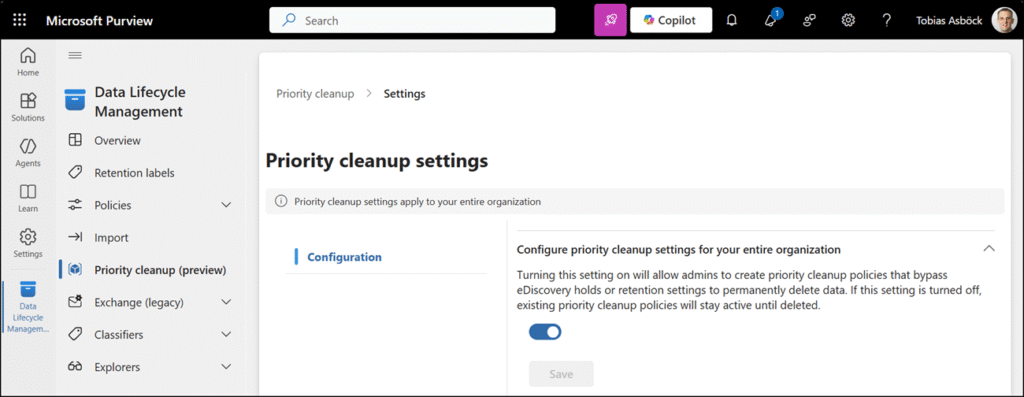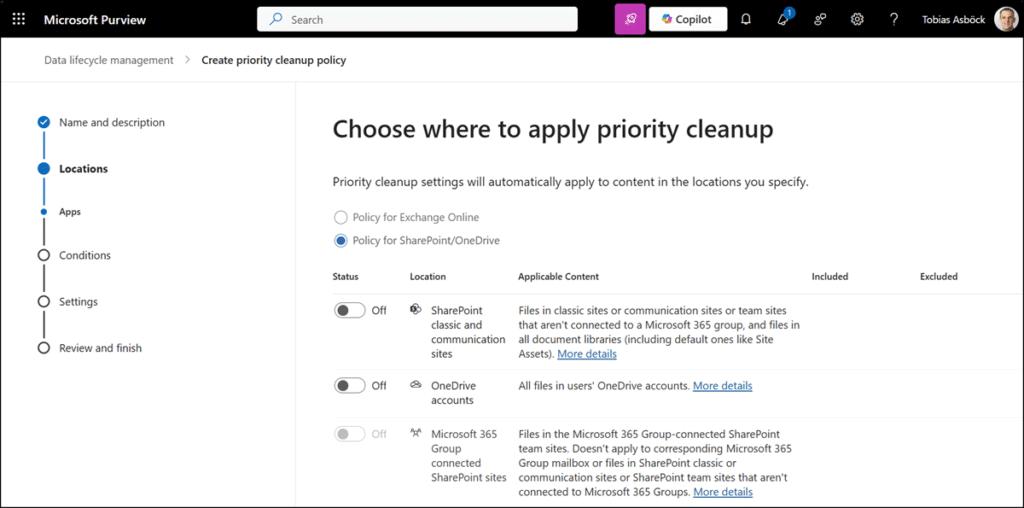Microsoft Purview Data Lifecycle Management is introducing Priority Cleanup for SharePoint and OneDrive. Priority Cleanup is a capability that allows admins to bypass existing retention policies and delete content in OneDrive and SharePoint Online before retention or hold periods expire.
This update targets organizations managing Copilot-related artifacts, such as Teams recordings and transcripts stored in OneDrive or SharePoint Online, as well as content retained in Preservation Hold libraries.
Timeline
General availability is planned for September 2025.
Impact for your organization
Priority Cleanup policies are part of Microsoft Purview Data Lifecycle Management. A Microsoft 365 E5 license or the E5 Compliance add-on is required. The policies were already available for Exchange Online mailboxes and now also support specific content in SharePoint and OneDrive.
The supported content includes:
- Copilot-related artifacts, such as Teams recordings and transcripts
- Preservation Hold library content after a user leaves the organization
Priority cleanup policies can be helpful in legal complaints, for example, when an organization must delete user data before a retention or hold duration expires. Or if an organization wants to eliminate unnecessary data for storage purposes.
Microsoft mentions two sample cases for priority cleanup in SharePoint:
Delete stale Teams meeting recordings and transcripts, turned on for Copilot recap
The Copilot in Teams recap feature uses Teams meeting recordings and transcripts that might be covered by a retention policy. These files are typically large and have little business value after 1–3 months.
Delete labeled items in OneDrive’s Preservation Hold library when a user leaves the organization
When items in a Preservation Hold library have an unexpired retention period, the user’s OneDrive site cannot be deleted. As a result, you may not be able to delete the OneDrive site until the longest retention period expires. Priority cleanup can delete these files instead of waiting for expiration, so you can then delete the user’s OneDrive site and reclaim storage space.
Priority Cleanup is enabled by default for the tenant, but can be turned off if required.

Because deletion forced by a priority cleanup policy is irreversible and can override existing holds and preservation locks, the process requires simulation mode, multiple approvals, and is audited.
- A priority cleanup policy for SharePoint requires running the policy in simulation mode. This is mandatory for SharePoint policies.
- All priority cleanup tasks are audited in the Microsoft Purview Audit Logs.
- A priority cleanup policy must be approved by at least one account (multiple approvers recommended).
- If an item identified for priority cleanup has a retention label applied, approval is also required from a retention management admin.
- If items for deletion are part of an eDiscovery review set, they will not be deleted until an eDiscovery admin approves the deletion.
- Accounts with the Microsoft Purview RBAC role Priority Cleanup Admin can manage the policies. See the prerequisites for details.
Priority Cleanup Admin
Access the Priority Cleanup tab within Data Lifecycle Management to create, update, and delete policies and modify Priority Cleanup settings for the tenant.
Priority Cleanup Viewer
Access Priority Cleanup tab within Data Lifecycle Management to view policies.

